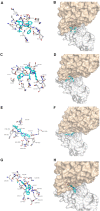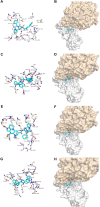Predicting the Animal Susceptibility and Therapeutic Drugs to SARS-CoV-2 Based on Spike Glycoprotein Combined With ACE2
- PMID: 33193684
- PMCID: PMC7645152
- DOI: 10.3389/fgene.2020.575012
Predicting the Animal Susceptibility and Therapeutic Drugs to SARS-CoV-2 Based on Spike Glycoprotein Combined With ACE2
Abstract
Recently, a few animals have been frequently reported to have been diagnosed with severe acute respiratory syndrome coronavirus 2 (SARS-CoV-2). Whether they are SARS-CoV-2 intermediate hosts is worthy of great attention. The interaction of SARS-CoV-2 spike protein and its acceptor protein ACE2 is an important issue in determining viral host range and cross-species infection, while the binding capacity of Spike protein to ACE2 of different species is unknown. Here, we used the atomic structure model of SARS-CoV-2 and human ACE2 to assess the receptor utilization capacity of ACE2s from 10 kinds of animals. Results show that chimpanzees, domestic cats and cattles are more susceptible to infection by SARS-CoV-2. Cats in particular, such as pet cats and stray cats, interact very closely with humans, implying the necessity to carefully evaluate the risk of cats during the current COVID-19 pandemic. Furthermore, based on ACE2(cats)-SARS-CoV-2-RBD model, through high-throughput screening methods using a pool of 30,000 small molecules, eight compounds were selected for binding free energy calculations. All the eight compounds can effectively interfere with the binding of ACE2 and Spike protein, especially Nelfinavir, providing drug candidates for the treatment and prevention of SARS-CoV-2, suggesting further assessment of the anti-SARS-CoV-2 activity of these compounds in cell culture. Although we only reported the results of the simulation, and more laboratory and epidemiological investigation are required. Like cats are a risk factor, we can further detect SARS-CoV-2 according to the susceptibility of different animals, find the potential host of infection, and completely cut off the living space of the virus. Especially, cats could be a choice of animal model for screening antiviral drugs or vaccine candidates against SARS-CoV-2.
Keywords: SARS-CoV-2; angiotensin-converting enzyme 2 (ACE2); binding affinity [K(b)]; cross-species transmission; nelfinavir (NFV).
Copyright © 2020 Shen, Liu, Xu, Ruan, Zhao, Zhang, Wang, Huang, Yang, Tang, Yang and Jia.
Figures




Similar articles
-
Variation in the ACE2 receptor has limited utility for SARS-CoV-2 host prediction.Elife. 2022 Nov 23;11:e80329. doi: 10.7554/eLife.80329. Elife. 2022. PMID: 36416537 Free PMC article.
-
Screening of inhibitors against SARS-CoV-2 spike protein and their capability to block the viral entry mechanism: A viroinformatics study.Saudi J Biol Sci. 2021 Jun;28(6):3262-3269. doi: 10.1016/j.sjbs.2021.02.066. Epub 2021 Feb 26. Saudi J Biol Sci. 2021. PMID: 33654454 Free PMC article.
-
Molecular simulation studies of the interactions between the human/pangolin/cat/bat ACE2 and the receptor binding domain of the SARS-CoV-2 spike protein.Biochimie. 2021 Aug;187:1-13. doi: 10.1016/j.biochi.2021.05.001. Epub 2021 May 11. Biochimie. 2021. PMID: 33984400 Free PMC article.
-
Interactions of angiotensin-converting enzyme-2 (ACE2) and SARS-CoV-2 spike receptor-binding domain (RBD): a structural perspective.Mol Biol Rep. 2023 Mar;50(3):2713-2721. doi: 10.1007/s11033-022-08193-4. Epub 2022 Dec 23. Mol Biol Rep. 2023. PMID: 36562937 Free PMC article. Review.
-
The expression of hACE2 receptor protein and its involvement in SARS-CoV-2 entry, pathogenesis, and its application as potential therapeutic target.Tumour Biol. 2021;43(1):177-196. doi: 10.3233/TUB-200084. Tumour Biol. 2021. PMID: 34420993 Review.
Cited by
-
Animal Transmission of SARS-CoV-2 and the Welfare of Animals during the COVID-19 Pandemic.Animals (Basel). 2021 Jul 8;11(7):2044. doi: 10.3390/ani11072044. Animals (Basel). 2021. PMID: 34359172 Free PMC article. Review.
-
The Upper Respiratory Tract of Felids Is Highly Susceptible to SARS-CoV-2 Infection.Int J Mol Sci. 2021 Sep 30;22(19):10636. doi: 10.3390/ijms221910636. Int J Mol Sci. 2021. PMID: 34638978 Free PMC article.
-
Investigating the active compounds and mechanism of HuaShi XuanFei formula for prevention and treatment of COVID-19 based on network pharmacology and molecular docking analysis.Mol Divers. 2022 Apr;26(2):1175-1190. doi: 10.1007/s11030-021-10244-0. Epub 2021 Jun 9. Mol Divers. 2022. PMID: 34105049 Free PMC article.
-
Promising natural products against SARS-CoV-2: Structure, function, and clinical trials.Phytother Res. 2022 Oct;36(10):3833-3858. doi: 10.1002/ptr.7580. Epub 2022 Aug 5. Phytother Res. 2022. PMID: 35932157 Free PMC article. Review.
-
Suspected Human-to-Cat Spillover of SARS-CoV-2 Omicron Variant in South Korea.Viruses. 2024 Jul 11;16(7):1113. doi: 10.3390/v16071113. Viruses. 2024. PMID: 39066274 Free PMC article.
References
-
- Beck B. R., Shin B., Choi Y., Park S., Kang K. (2020). Predicting commercially available antiviral drugs that may act on the novel coronavirus (SARS-CoV-2) through a drug-target interaction deep learning model. Comput. Struct. Biotechnol. J. 18 784–790. 10.1016/j.csbj.2020.03.025 - DOI - PMC - PubMed
-
- Brune M. E., Katwala S. P., Milicic I., Witte D. G., Kerwin J. F., Jr., Meyer M. D., et al. (2002). Effect of fiduxosin, an antagonist selective for alpha(1A)- and alpha(1D)-adrenoceptors, on intraurethral and arterial pressure responses in conscious dogs. J. Pharmacol. Exp. Ther. 300 487–494. Case Study Shows Asymptomatic Transmission of COVID-19 in China. 10.1124/jpet.300.2.487 - DOI - PubMed
-
- Connelly M., Sekhon S., Stephens D., Boorigie M., Bickel J. (2020). Enhancing outpatient dihydroergotamine infusion with interdisciplinary care to treat refractory pediatric migraine: preliminary outcomes from the comprehensive aggressive migraine protocol (”CAMP”). Headache 60 101–109. 10.1111/head.13685 - DOI - PubMed
LinkOut - more resources
Full Text Sources
Miscellaneous

